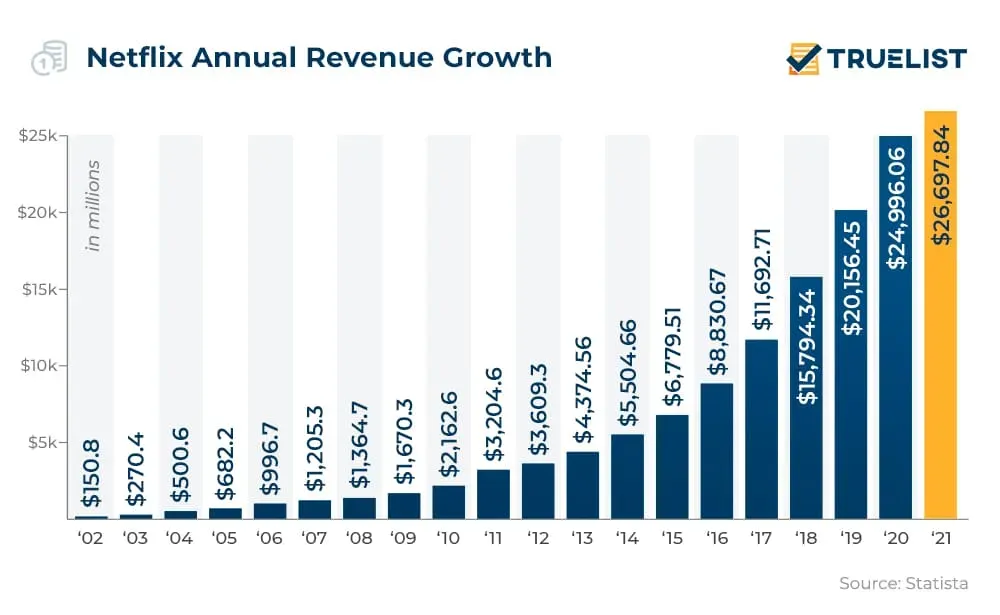Netflix revenue growth has been a focal point in the streaming industry’s evolution, particularly highlighted in their recent earnings report for Q2 2025. The entertainment giant announced a 16% increase in revenue, reaching an impressive $11.08 billion, which has surpassed analysts’ expectations. This surge is attributed to strong member growth, strategic price adjustments, and enhanced ad sales, showcasing Netflix’s robust market presence. With a revised full-year revenue forecast between $44.8 billion and $45.2 billion, the company continues to build investor confidence amidst fluctuating currency challenges. In this context, Netflix’s future remains promising as it adapts to changing consumer behaviors and competitive pressures, paving the way for sustained expansion in its subscriber base and overall market performance.
The remarkable financial performance of Netflix also reflects its adaptability in a rapidly shifting landscape of digital media. As streaming services compete for viewer attention, Netflix’s innovative approach to engaging content and advertising strategies has propelled its earnings to new heights. Looking at their Q2 earnings, the increase in user acquisition and the bolstered revenue from advertisements indicate a successful pivot towards a more diversified income model for the platform. Moreover, the anticipation of future blockbuster releases and series could further drive Netflix’s member growth and fortify its position as a leader in the industry. As the year progresses, the insights from Netflix subscription data and earnings forecasts will be crucial in understanding the trajectory of the streaming giant.
Netflix Revenue Growth in Q2 2025
Netflix experienced impressive financial performance in the second quarter of 2025, with revenue growth of 16% year-over-year, reaching $11.08 billion. This surge can be attributed to several factors, including a notable increase in subscriber numbers and elevated subscription pricing. Furthermore, the company’s ad sales have played a critical role in enhancing revenue, showcasing the efficacy of Netflix’s advertising strategy. Analysts’ expectations were met with a slight margin, reflecting Netflix’s strengthening position in the dynamic streaming market.
The updated revenue forecast suggests an optimistic outlook for Netflix, predicting that annual revenue will fall between $44.8 billion and $45.2 billion, which is significantly higher than previous estimates. This revision not only underscores the company’s strong performance but also showcases its ability to adapt to market changes, such as currency fluctuations. With member growth on the rise, Netflix seems poised to capitalize on the growing demand for streaming content, further solidifying its leadership role in the industry.
Impact of Netflix Subscription Data on Financial Performance
Though Netflix opted not to disclose detailed subscription data for the second quarter, the implications of this decision are significant. Subscribers remain central to Netflix’s revenue strategy, and the company has seen a positive trajectory in member growth, which is critical for sustaining its revenue increase. The correlation between subscription numbers and financial performance is evident, as a rise in members directly contributes to higher sales and revenue figures.
Moreover, the reduction in emphasis on subscription data reporting does not indicate a decline in focus on member retention or acquisition. Instead, it reflects a strategic pivot as Netflix continues to innovate with its content offerings, such as anticipated sequels and new productions like ‘Wednesday’ and ‘Stranger Things.’ Maintaining a loyal subscriber base while attracting new members will be key to future earnings, especially in a competitive market landscape.
Forecasts for Netflix’s subscriber growth remain strong, reinforcing market confidence in its long-term sustainability. Investors should monitor such metrics closely, as robust subscriber engagement can lead to increased revenues, particularly in light of Netflix’s rising ad sales that also complement its subscription model.
Netflix Ad Sales: Transforming Revenue Streams
Netflix’s strategy to incorporate ad sales is transforming how the company generates revenue in a highly competitive space. In Q2 2025, rising ad revenue was highlighted as a significant contributor to the overall growth in earnings. This model has allowed Netflix to tap into a new revenue stream without compromising its subscription-based foundation, appealing to a broader audience as advertisers seek to engage with viewers.
The advertising strategy has proven successful, integrating advertisement placements within the viewing experience while ensuring that content remains a priority. With plans to expand its advertising offerings, Netflix expects ad revenues to grow even more. This dual revenue approach – combining subscriptions and advertising – positions Netflix uniquely, allowing the platform not just to enhance user experience but also to maximize profit generation across diverse channels.
Netflix’s Strong Financial Metrics and Future Outlook
In a strategic overview of Netflix’s financial metrics, the company showcased robust operating margins at 34.1%, demonstrating effective cost management amidst an expansive content slate. The increase of over 3 percentage points from the previous quarter indicates that Netflix is efficiently balancing production costs while delivering high-quality content. This operational efficiency is crucial for sustaining profitability as Netflix continues to invest heavily in original productions.
Despite this strong performance, caution has been expressed regarding the second half of 2025, where operating margins may decline due to heightened costs associated with content production and marketing. Investors should remain attentive to how Netflix navigates these challenges, particularly with an impressive lineup of new releases which could significantly impact viewership and consequently, revenue in the upcoming quarters.
Analyzing Netflix’s Q2 2025 Earnings Compared to Analyst Expectations
Netflix’s latest earnings release exceeded several analysts’ expectations, showcasing the company’s resilience in the evolving streaming landscape. Earnings per share of $7.19 surpassed the expected $7.08, reflecting the effectiveness of Netflix’s growth strategies in adapting to market demands. Revenue figures slightly outperformed projections, affirming the company’s forecasting accuracy and its response to ongoing economic shifts.
The comparison to analyst estimates reveals that Netflix is not just managing to meet industry standards; it is set to become a benchmark for performance in the streaming service sector. The company’s initiatives, focusing on quality content and enhanced user engagement, have paid dividends, positioning it favorably against competitors who are still grappling with subscriber retention and content relevancy.
Member Growth: A Key Driver of Netflix’s Revenue
Member growth remains one of the most pivotal indicators of Netflix’s financial health. The latest figures suggest a healthy influx of new subscribers, attributable to the company’s vast and diverse content library. This expansion is essential, as each new member directly contributes to revenue through subscription fees, which have also seen increases in price, thereby bolstering overall earnings.
As Netflix aims to grow its global reach further, retention strategies alongside acquisition tactics will play significant roles in maintaining this growth momentum. With an engaging slate of upcoming shows and film releases, the company is positioned to continue attracting new members while keeping existing viewers satisfied, ultimately translating to sustained revenue increases in the competitive streaming environment.
Navigating the Competitive Landscape of Streaming
As the streaming landscape becomes increasingly competitive, Netflix continues to adapt its business strategies to maintain market leadership. The company has emphasized developing original and exclusive content to differentiate itself from peers like Amazon Prime Video and Disney+, which is crucial for attracting and holding subscribers. Innovation in content offerings, along with strategic partnerships for marketing, has enabled Netflix to enhance its brand visibility and appeal.
Furthermore, the evolving nature of viewer preferences requires Netflix to remain agile in its content curation and technological advancements. The integration of features such as online watch parties and enhanced recommendations powered by machine learning places Netflix in a favorable position to enhance user experience, thereby driving member growth and ultimately, revenue.
The Significance of Free Cash Flow for Netflix
In the financial landscape, free cash flow stands as a critical metric among investors and stakeholders. For Netflix, the rise in free cash flow to $2.3 billion marks a significant achievement, reflecting its ability to generate cash from operations after covering capital expenditures. This improvement allows Netflix the flexibility to invest in new content while also targeting debt reduction and other strategic financial moves.
The guidance for free cash flow between $8 billion and $8.5 billion for the year indicates robust management of resources within the company. Increased cash flow enhances Netflix’s capability to sustain and grow its content pipeline, which is essential for competitive advantage. As the streaming wars intensify, having a solid financial footing will equip Netflix to tackle challenges and seize growth opportunities.
Future Content Strategy and Its Financial Implications
Looking ahead, Netflix’s content strategy plays a vital role in shaping its financial performance. With an attractive slate including anticipated sequels and new original productions, Netflix aims to capture a larger audience and boost subscriber engagement, which directly impacts revenue generation. The reliance on high-profile releases, like the finale of major series, signals a strategic shift towards leveraging popular cultural moments to drive viewership.
However, the company must also balance this with cost management, as increased content creation can lead to rising expenses. The interplay between investing in quality content while maintaining profitability will be crucial for Netflix’s success in retaining existing members and attracting new ones, which in turn relies on favorable earnings and robust revenue figures.
Frequently Asked Questions
What factors contributed to Netflix’s revenue growth in Q2 2025?
Netflix’s revenue growth of 16% in Q2 2025 was primarily driven by an increase in membership numbers, elevated subscription pricing, and higher ad sales. The boost in revenue is also linked to the weakening of the U.S. dollar against other currencies.
How did Netflix’s earnings report in Q2 2025 affect its revenue forecast?
Following its successful earnings report where Netflix posted revenues of $11.08 billion, the company increased its full-year revenue forecast to between $44.8 billion and $45.2 billion. This adjustment reflects both healthy member growth and ongoing ad sales.
What impact did Netflix’s member growth have on its revenue growth?
The significant member growth reported by Netflix was a key driver behind its impressive revenue growth in Q2 2025. This increase in subscribers not only contributed to higher subscription revenue but also impacted overall earnings positively.
What are the expectations for Netflix’s ad sales in relation to its revenue growth?
Netflix’s updated revenue forecast highlights expectations for continued strong ad sales, which are expected to play a vital role in boosting the company’s revenue growth moving forward, complementing the income generated from membership subscriptions.
What insights does Netflix provide on subscription data following Q2 2025?
Netflix has opted not to provide quarterly updates on subscription data for the second consecutive quarter. However, they have indicated that revenue growth was positively impacted this quarter by an increase in members.
How did the performance of Netflix’s earnings per share correlate with its revenue growth?
In Q2 2025, Netflix reported earnings per share of $7.19, which slightly exceeded analyst expectations. The strong earnings per share are reflective of the overall revenue growth and increased net income, bolstered by the rising subscription base and ad revenue.
What challenges might Netflix face in maintaining its revenue growth in the latter half of 2025?
Despite robust revenue growth in the first half of 2025, Netflix cautioned that operating margins may decline in the latter half of the year due to increased content amortization and higher sales and marketing costs in light of a substantial calendar of releases.
How does Netflix’s free cash flow forecast connect to its overall revenue growth?
Netflix raised its full-year free cash flow guidance to between $8 billion and $8.5 billion, reflecting strong operating cash flow and overall revenue growth. This increase is crucial for funding new content and sustaining the growth strategy.
What can subscribers expect from Netflix’s upcoming content that will influence revenue growth?
Subscribers can look forward to a robust lineup of new releases, including popular series like “Wednesday” and “Stranger Things,” which are anticipated to drive member engagement and, consequently, support ongoing revenue growth.
How did the U.S. dollar’s performance influence Netflix’s revenue growth in 2025?
Netflix’s revenue forecast increase was partly attributed to the weakening of the U.S. dollar, which positively impacted international revenue, contributing to overall revenue growth as reported in Q2 2025.
| Key Metrics | Q2 2025 Performance | Comparison to Estimates | Forecasts |
|---|---|---|---|
| Revenue Growth | 16% year-over-year increase, reaching $11.08 billion | Analysts expected $11.07 billion revenue | Full-year revenue forecast revised to $44.8-$45.2 billion (from previous $43.5-$44.5 billion) |
| Earnings per Share (EPS) | $7.19 per share, up from $4.88 in Q2 2024 | Analysts expected $7.08 per share | Free cash flow guidance raised to $8-$8.5 billion |
| Net Income | $3.1 billion, representing a significant increase | N/A | Operating margin projected to decrease in 2H 2025 |
| Operating Cash Flow | $2.4 billion, up 84% year-over-year | N/A | Upcoming strong content lineup (includes ‘Stranger Things’ finale) |
Summary
Netflix revenue growth is on a promising trajectory as evidenced by its recent earnings report, which surpassed analyst expectations with a revenue increase of 16% for the second quarter of 2025. This growth is attributed to a rise in membership numbers, higher pricing strategies, and robust advertising revenue. With full-year revenue forecasts updated to between $44.8 billion and $45.2 billion, Netflix continues to showcase its strength in the streaming industry. However, despite this positive outlook, potential challenges in maintaining operating margins remain, especially as content costs are set to rise in the latter half of the year. Overall, the company’s strategic focus on quality content and continued investment will be crucial as it navigates through increased operational costs.



